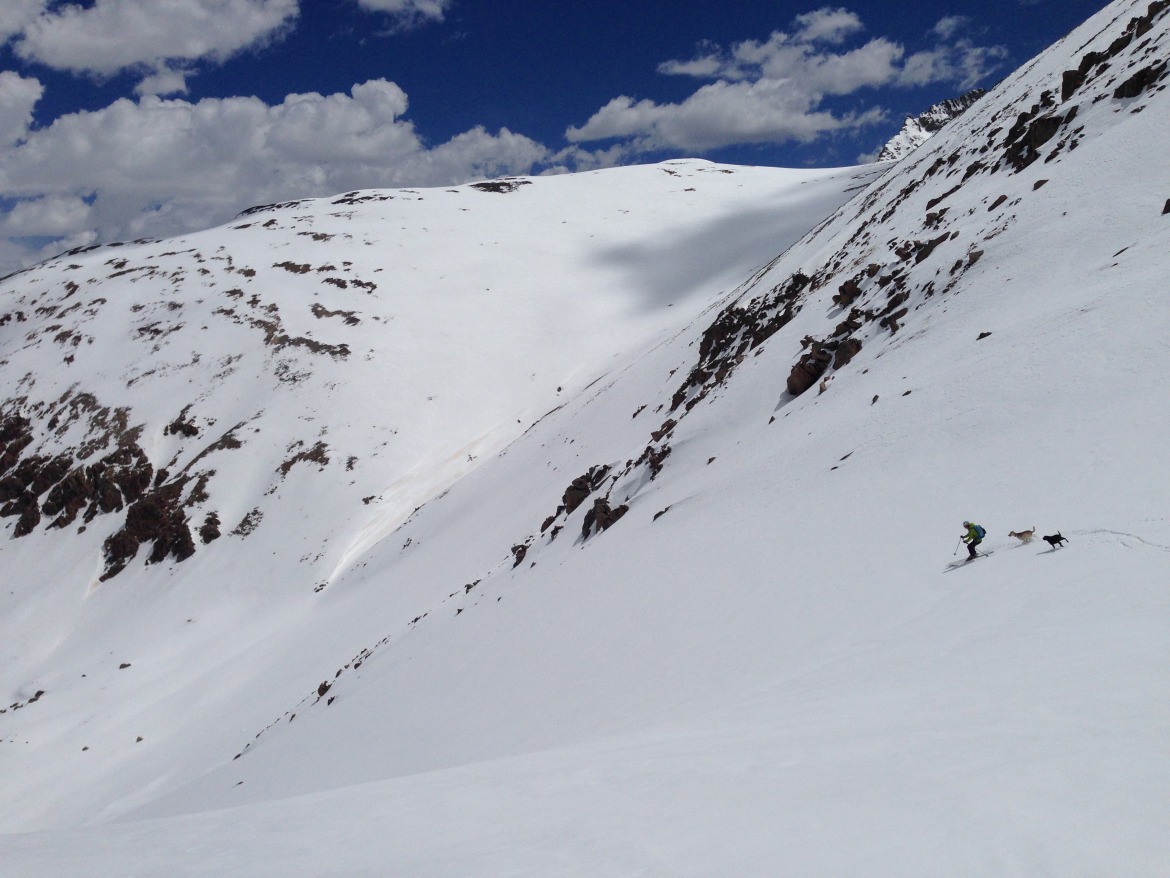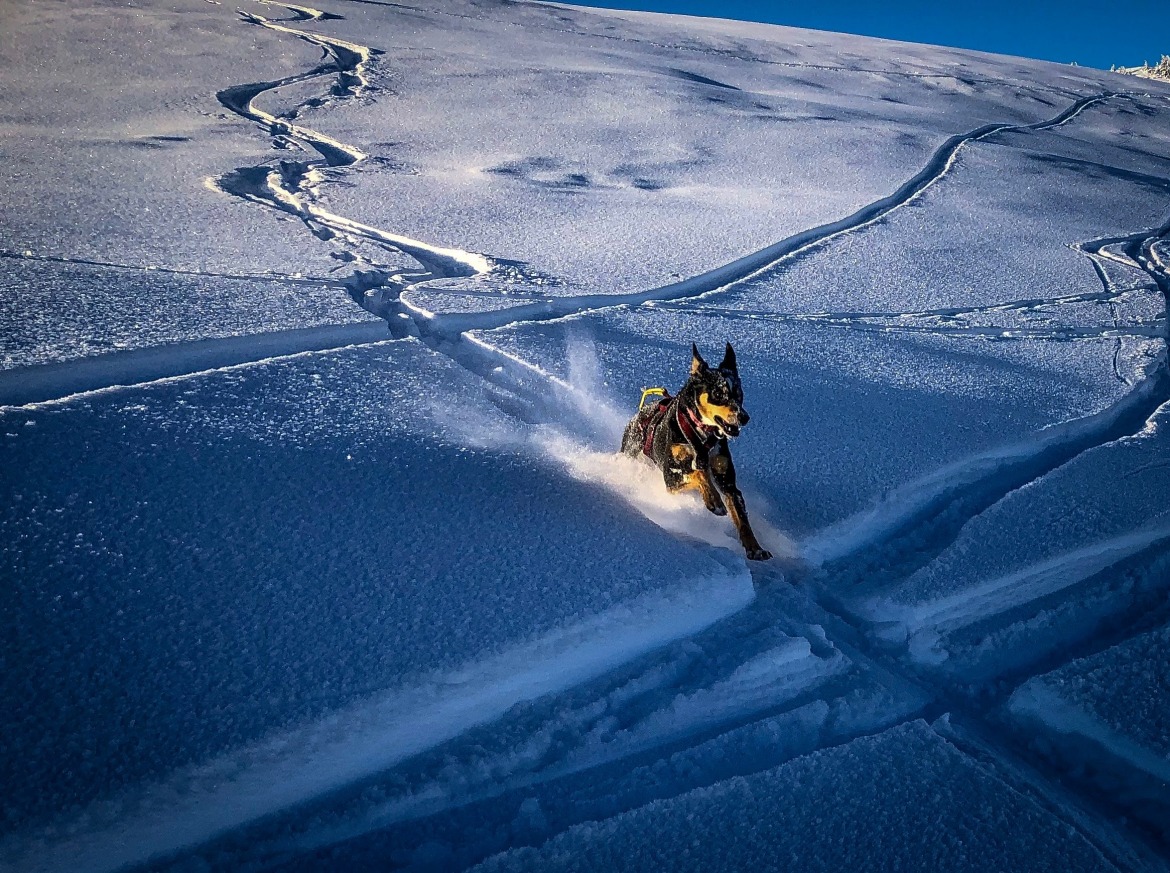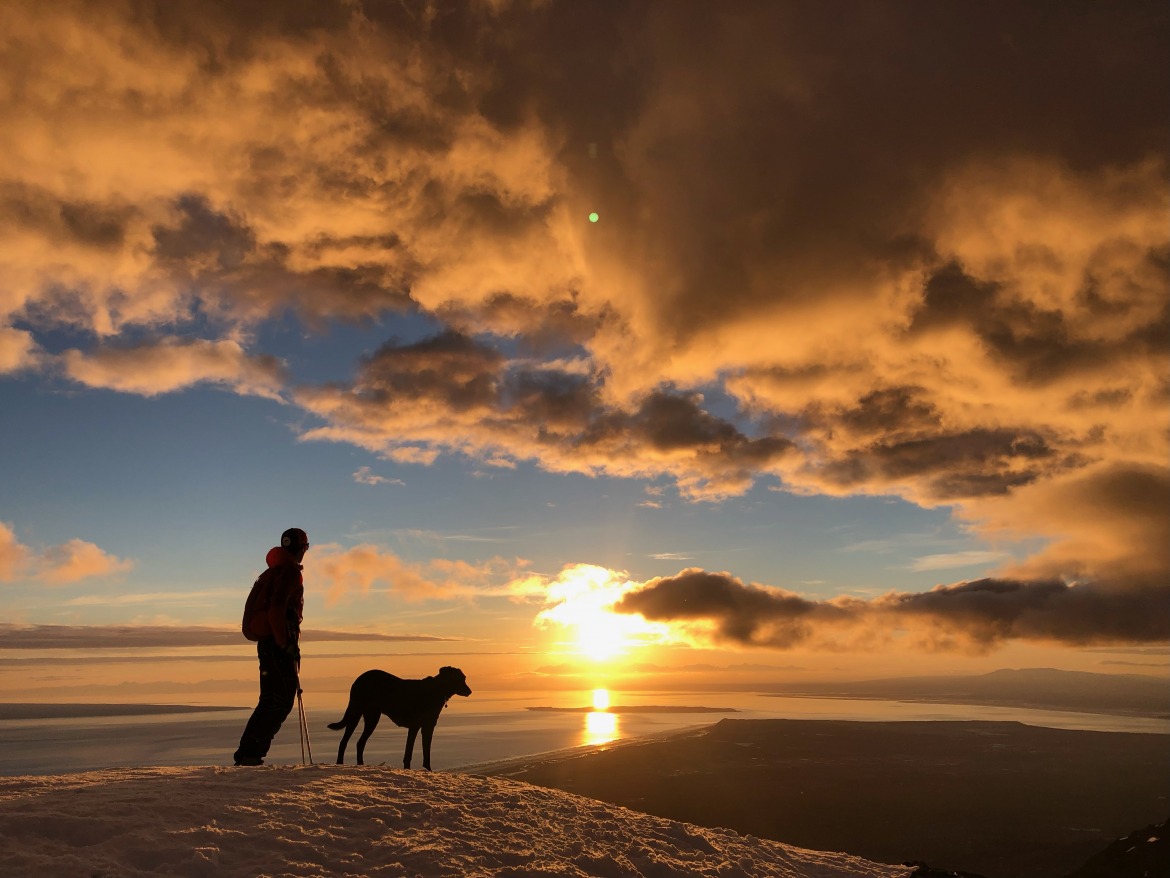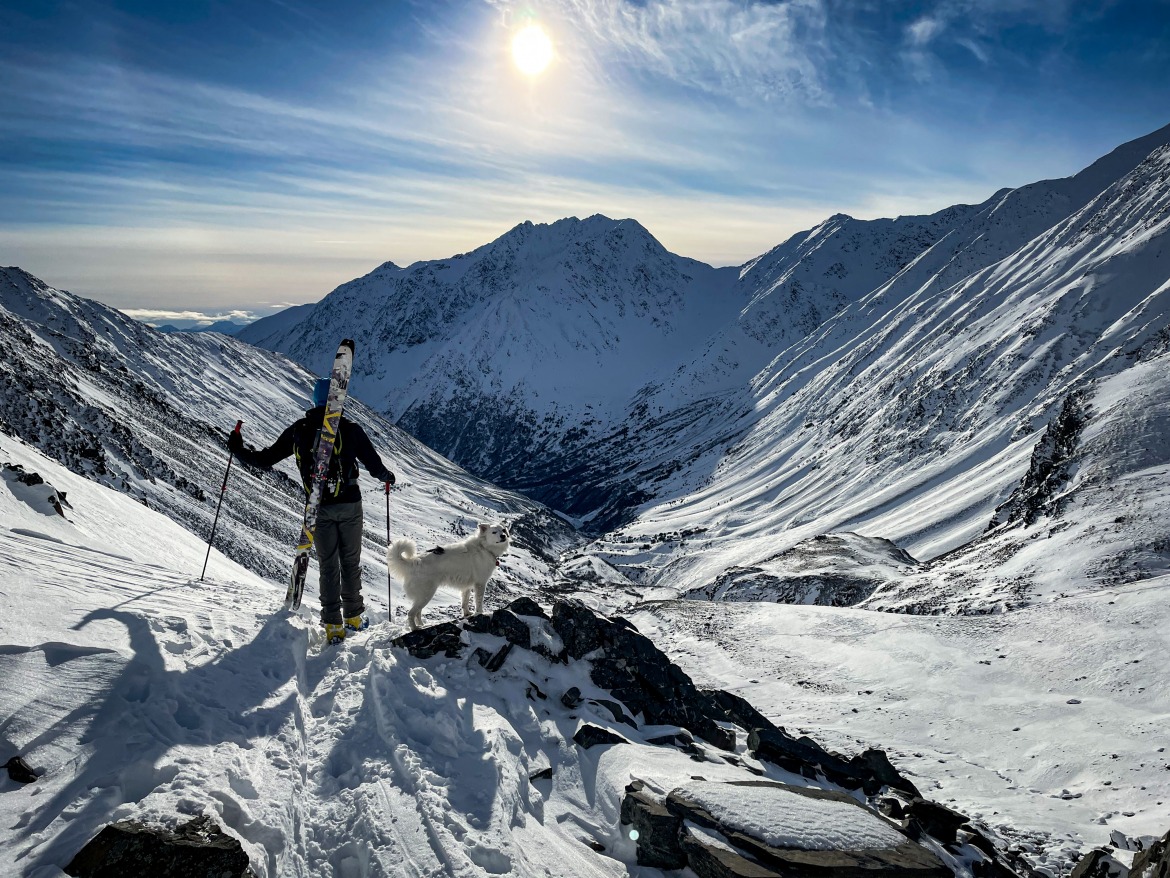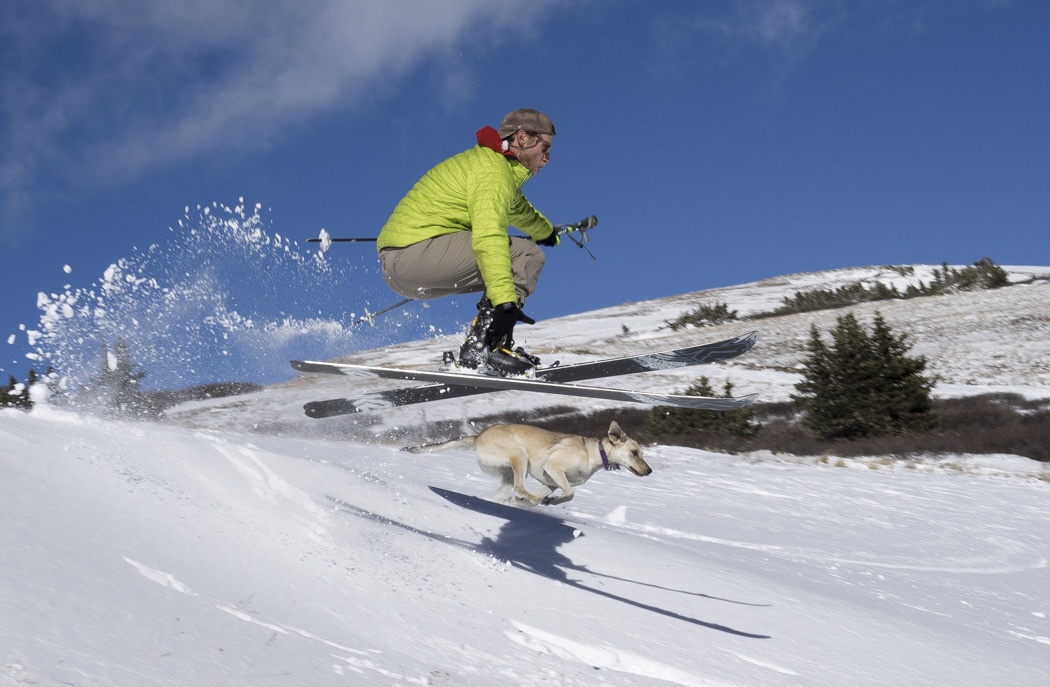
Sadie and yours truly having a hoot on an a Colorado October day – Taylor Pass, ten years ago. Photo by Jim Cezo
A person’s best friend. You know where we are going: dogs in the backcountry. Many words come to mind, like liability, poop, sit, stay, treat, dog-person, and cat-person. But damn, they are lovable. Do they belong out there with us?
Sadie loved skiing more than anyone I have ever met. Maybe I should say she loved going skiing – as she was a dog, she was not on skis herself, but rather leaped paw over paw through any pow she could find. She was a sled dog mut from Fairbanks who found her way to our family in Leadville, Colorado. If I grabbed skins, ski boots, or any piece of the backcountry kit, she would eagerly run to the door, refusing to be left at home. She didn’t mind early mornings and relished the days I brought along smoked salmon. We lost Sadie to cancer, but not before she ticked off several 14er descents, countless pow days, returned to her home state of AK, and clocked in more big vert days than the most enthusiastic of die-hards, as she regularly skied any given run three times to my one. I miss her on every skin track.
Sadie was my friend, so I brought her along skiing – it was that simple. However, in the years since, I have changed my mind considerably on skiing with dogs.
Our pack numbers rebounded when Charger entered our household four years ago. He came with the name, but it is well-deserved. An Iditarod team drop out (with cousins who have won the race), he and my wife skijour at what I consider to be mind-numbing speeds on nordic gear. One afternoon in the winter he first joined the fam, he came out on a ski tour on our local milk run outside of Anchorage. Leaping in front of Margi (my wife) as she came towards the bottom of the run, they nearly collided. Limping over to us just after the near pile up, we realized his leg had been cut open by her ski edge. I wrapped the injury in my buff, picked him up and skied back to the car. While he was getting stitched up by the vet, we were told he was the third dog that day brought in with the same injury–cut by a ski.
Rules of Engagement
Skiing with dogs is so tempting. But truthfully it is also dangerous, it often seems to ignore the dog’s interests, and frankly it can be tough to tell the difference between stress and fun when dogs are out and about in a new environment. Avalanche terrain and metal edges present the most obvious risks, but wildlife, cold, and other people can all present real risks to our furry friends. My other dog, Ziggy (a 15 year old lab), once got a face full of porcupine quills at 13,000ft, heading up Mt. Giesler on Independence Pass….no clue what the porcupine was doing up there, but the dog found it. Dogs also create considerable risks for us humans and can impose those risks on others around us (I have seen dogs running around start zones above other skiers – not a good look).
Ziggy is long retired, but Charger still jumps at the opportunity to come along when things line up. I love skiing with my dog, but he is only allowed to tag along under special conditions:
— It’s a pow day where he is much slower than anyone in the group on the downs.
— We are not in avalanche terrain.
— It’s not a crowded zone.
— We are not out for a big day.
— My ski partners have approved.
He still laps plenty of miles on the local nordic trails as a staunch winter enthusiast, but I have personally moved away from including dogs on the regular backcountry roster.
Here are a few thoughts from others:
Malcolm H., dog person: “Dogs aren’t great ski partners…I’ve heard of dogs dying, dogs triggering avalanches above people, and dogs getting pushed off things by slough…dogs dropped a cornice onto some friends. Basically they are shitty in avalanche terrain. Even in non-avy terrain, I think a lot of people are oblivious that their dog is out of its element…”
Nick M., Californian, alleged cat person: “If a dog poses no objective hazard to others, then dog owners should be able to have fun with their pets. That means dogs probably should not go into avalanche terrain or be allowed to chase other groups, but I don’t have a dog and have not spent much time skiing with a dog; maybe I would feel differently if I did.”
Margi D., skijorer: “You have to be prepared to treat any injury in the backcountry. If you bring a dog, that means you have to be ready to treat or evacuate them just as you would other members of your party.”
Joe M., former dog handler: “Dogs are “variables” by nature. Navigating the backcountry, especially avalanche terrain is about minimizing variables to the best of one’s abilities. Introducing more variables just doesn’t make sense. That said, super low angle butt wiggle zones are just fine.”
Adam J., amateur dog photographer: “I love skiing with my dog. He always seems stoked to be out there too. But there are days that it’s safer to leave him at home. It really depends on the dog’s abilities, if there are crevasses, deep willowy snow, and how big of a day you’re planning. A dog has to work a lot harder post-holing in a bottomless skin track and porpoising down several thousand foot powder runs than you do gliding on skis. But when things line up, skiing with dogs is great. Plus, peak photos are always better with a pup on top!”
Tom F., chihuahua owner: “Only in specific circumstances – short day, mellow terrain, green light. Too much risk to you, others, and the dog otherwise.”
Anything else you would add?
Update in light of recent comment: After careful consideration, Dr. Lee now goes as Professor Lee, pretentious Ph.D. though if you’re friends you can still call him Alex, unless he’s wearing tweed or leather boots…Although not an MD, his parents are still proud.
Dr. Alex Lee lives in Anchorage, Alaska. Alex is a professor at Alaska Pacific University, teaching philosophy and environmental studies. He also works as a sometimes guide, naturalist, writer, and photographer.

